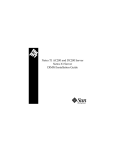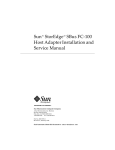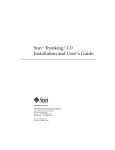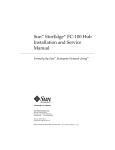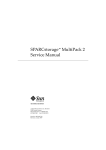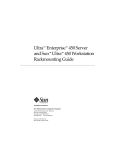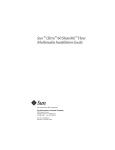Download Sun™ FastEthernet PCI Adapter Product Note
Transcript
Sun™ FastEthernet PCI Adapter Product Note A Sun Microsystems, Inc. Business 901 San Antonio Road Palo Alto, California 94303 USA 415 960-1300 fax 415 969-9131 Part No.: 805-2715-10 Revision A, August 1997 Copyright 1997 Sun Microsystems, Inc. 2550 Garcia Avenue, Mountain View, California 94043-1100 U.S.A. All rights reserved. This product or document is protected by copyright and distributed under licenses restricting its use, copying, distribution, and decompilation. No part of this product or document may be reproduced in any form by any means without prior written authorization of Sun and its licensors, if any. Third-party software, including font technology, is copyrighted and licensed from Sun suppliers. Parts of the product may be derived from Berkeley BSD systems, licensed from the University of California. UNIX is a registered trademark in the U.S. and other countries, exclusively licensed through X/Open Company, Ltd. Sun, Sun Microsystems, the Sun logo, AnswerBook, SunDocs, FastEthernet, SunSwift, and Solaris are trademarks, registered trademarks, or service marks of Sun Microsystems, Inc. in the U.S. and other countries. All SPARC trademarks are used under license and are trademarks or registered trademarks of SPARC International, Inc. in the U.S. and other countries. Products bearing SPARC trademarks are based upon an architecture developed by Sun Microsystems, Inc. The OPEN LOOK and Sun™ Graphical User Interface was developed by Sun Microsystems, Inc. for its users and licensees. Sun acknowledges the pioneering efforts of Xerox in researching and developing the concept of visual or graphical user interfaces for the computer industry. Sun holds a non-exclusive license from Xerox to the Xerox Graphical User Interface, which license also covers Sun’s licensees who implement OPEN LOOK GUIs and otherwise comply with Sun’s written license agreements. RESTRICTED RIGHTS: Use, duplication, or disclosure by the U.S. Government is subject to restrictions of FAR 52.227-14(g)(2)(6/87) and FAR 52.227-19(6/87), or DFAR 252.227-7015(b)(6/95) and DFAR 227.7202-3(a). DOCUMENTATION IS PROVIDED “AS IS” AND ALL EXPRESS OR IMPLIED CONDITIONS, REPRESENTATIONS AND WARRANTIES, INCLUDING ANY IMPLIED WARRANTY OF MERCHANTABILITY, FITNESS FOR A PARTICULAR PURPOSE OR NONINFRINGEMENT, ARE DISCLAIMED, EXCEPT TO THE EXTENT THAT SUCH DISCLAIMERS ARE HELD TO BE LEGALLY INVALID. Copyright 1997 Sun Microsystems, Inc., 2550 Garcia Avenue, Mountain View, Californie 94043-1100 Etatis-Unis. Tous droits réservés. Ce produit ou document est protégé par un copyright et distribué avec des licences qui en restreignent l’utilisation, la copie, la distribution, et la décompilation. Aucune partie de ce produit ou document ne peut être reproduite sous aucune forme, par quelque moyen que ce soit, sans l’autorisation préalable et écrite de Sun et de ses bailleurs de licence, s’il y en a. Le logiciel détenu par des tiers, et qui comprend la technologie relative aux polices de caractères, est protégé par un copyright et licencié par des fournisseurs de Sun. Des parties de ce produit pourront être dérivées des systèmes Berkeley BSD licenciés par l’Université de Californie. UNIX est une marque déposée aux Etats-Unis et dans d’autres pays et licenciée exclusivement par X/Open Company, Ltd. Sun, Sun Microsystems, le logo Sun, AnswerBook, SunDocs, FastEthernet, SunSwift, et Solaris sont des marques de fabrique ou des marques déposées, ou marques de service, de Sun Microsystems, Inc. aux Etats-Unis et dans d’autres pays. Toutes les marques SPARC sont utilisées sous licence et sont des marques de fabrique ou des marques déposées de SPARC International, Inc. aux Etats-Unis et dans d’autres pays. Les produits portant les marques SPARC sont basés sur une architecture développée par Sun Microsystems, Inc. L’interface d’utilisation graphique OPEN LOOK et Sun™ a été développée par Sun Microsystems, Inc. pour ses utilisateurs et licenciés. Sun reconnaît les efforts de pionniers de Xerox pour la recherche et le développement du concept des interfaces d’utilisation visuelle ou graphique pour l’industrie de l’informatique. Sun détient une licence non exclusive de Xerox sur l’interface d’utilisation graphique Xerox, cette licence couvrant également les licenciés de Sun qui mettent en place l’interface d’utilisation graphique OPEN LOOK et qui en outre se conforment aux licences écrites de Sun. CETTE PUBLICATION EST FOURNIE "EN L’ETAT" ET AUCUNE GARANTIE, EXPRESSE OU IMPLICITE, N’EST ACCORDEE, Y COMPRIS DES GARANTIES CONCERNANT LA VALEUR MARCHANDE, L’APTITUDE DE LA PUBLICATION A REPONDRE A UNE UTILISATION PARTICULIERE, OU LE FAIT QU’ELLE NE SOIT PAS CONTREFAISANTE DE PRODUIT DE TIERS. CE DENI DE GARANTIE NE S’APPLIQUERAIT PAS, DANS LA MESURE OU IL SERAIT TENU JURIDIQUEMENT NUL ET NON AVENU. Please Recycle Sun FastEthernet PCI Adapter Product Note This document contains the late-breaking news and documentation updates for the Sun™ FastEthernet™ PCI adapter. Replacing a SunSwift PCI Adapter With a Sun FastEthernet PCI Adapter in the Same PCI Slot Your system will encounter network problems if you replace a SunSwift™ PCI adapter with a Sun FastEthernet PCI adapter, or if you replace a Sun FastEthernet PCI adapter with a SunSwift PCI adapter, in the same PCI slot. To avoid these problems, you must rename the /etc/hostname.hme<num> file on your system to reflect the new adapter’s Ethernet interface. The /etc/path_to_inst file will be updated when you perform a reconfiguration boot on your system after installing the new PCI adapter. ■ If you are replacing a SunSwift PCI adapter with a Sun FastEthernet PCI adapter, see page 2. ■ If you are replacing a Sun FastEthernet PCI adapter with a SunSwift PCI adapter, see page 4. Note – If you are adding a new adapter into a different PCI slot, refer to the adapter’s installation and user’s Guide for instructions on how to install the adapter and configure the software. 1 ▼ To Replace the SunSwift PCI Adapter With a Sun FastEthernet PCI Adapter in the Same PCI Slot Note – Refer to your system’s installation or service manual for detailed instructions for the following three steps. 1. Power off your system and open the system unit. 2. Replace the SunSwift PCI adapter with the Sun FastEthernet PCI adapter. 3. Close the system unit. 4. Power on the system, and when the OpenBoot PROM’s banner is displayed, press the Stop-A keys to interrupt the boot process and to display the ok prompt. 5. At the ok prompt, use the show-nets command to list the system’s network devices and to verify the Sun FastEthernet PCI adapter’s installation. You will see the system’s network devices, which should be similar to the example below. ok show-nets a) /pci@1f,4000/SUNW,hme@2,1 b) /pci@1f,4000/network@1,1 q) NO SELECTION Enter Selection, q to quit: q ok ■ ■ hme identifies the Sun FastEthernet PCI adapter’s Ethernet device network identifies the on-board Ethernet Device Make a note of the Sun FastEthernet PCI adapter’s hme pathname for future reference. Note – If these devices are not listed, check that the adapter is properly seated and reinstall the adapter, if necessary. 2 Sun FastEthernet PCI Adapter Product Note • August 1997 6. Perform a reconfiguration boot on your system. ok boot -r After rebooting your system, login as super-user (root). 7. At the command line, use the grep command to search the /etc/path_to_inst file for hme devices. # grep hme /etc/path_to_inst "/pci@1f,4000/network@1,1" 0 "hme" "/pci@1f,4000/pci@2/SUNW,hme@0,1" 1 "hme" "/pci@1f,4000/SUNW,hme@2,1" 2 "hme" (On-board hme interface) (SunSwift PCI hme interface) (Sun FastEthernet PCI hme interface) In the example above, the network@1,1 instance is the on-board FastEthernet device, the old SUNW,hme@0,1 instance is for the previous SunSwift PCI adapter, and the new SUNW,hme@2,1 instance is for the Sun FastEthernet PCI adapter. You will need to know the instance number for Sun FastEthernet PCI adapter. In the above example, the instance number for the Sun FastEthernet PCI adapter is 2, which is shown in bold. 8. Using the instance number found in Step 7, rename the /etc/hostname.hme<num> file previously used by the SunSwift PCI adapter to reflect the new instance number used by the Sun FastEthernet PCI adapter. For example, if the previous file had an *.hme1 extension, and the new instance number is 2, you would type: # mv /etc/hostname.hme1 /etc/hostname.hme2 9. Halt and reboot your system. # init 6 Note – Refer to the Sun FastEthernet PCI Adapter Installation and User’s Guide for more information about configuring the driver software. Sun FastEthernet PCI Adapter Product Note 3 ▼ To Replace the Sun FastEthernet PCI Adapter With a SunSwift PCI Adapter in the Same PCI Slot Note – Refer to your system’s installation or service manual for detailed instructions for the following three steps. 1. Power off your system and open the system unit. 2. Replace the Sun FastEthernet PCI adapter with the SunSwift PCI adapter. 3. Close the system unit. 4. Power on the system, and when the OpenBoot PROM’s banner is displayed, press the Stop-A keys to interrupt the boot process and to display the ok prompt. 5. At the ok prompt, use the show-nets command to list the system’s network devices and to verify the SunSwift PCI adapter’s installation. You will see the system’s network devices, which should be similar to the example below. ok show-nets a) /pci@1f,4000/pci@2/SUNW,hme@0,1 b) /pci@1f,4000/network@1,1 q) NO SELECTION Enter Selection, q to quit: q ok ■ ■ hme identifies the SunSwift PCI adapter’s Ethernet device network identifies the on-board Ethernet Device Make a note of the SunSwift adapter’s hme pathname for future reference. Note – If these devices are not listed, check that the adapter is properly seated and reinstall the adapter, if necessary. 6. Perform a reconfiguration boot on your system. ok boot -r After rebooting your system, login as super-user (root). 4 Sun FastEthernet PCI Adapter Product Note • August 1997 7. At the command line, use the grep command to search the /etc/path_to_inst file for hme devices. # grep hme /etc/path_to_inst "/pci@1f,4000/network@1,1" 0 "hme" "/pci@1f,4000/SUNW,hme@2,1" 1 "hme" "/pci@1f,4000/pci@2/SUNW,hme@0,1" 2 "hme" (On-board hme interface) (Sun FastEthernet PCI hme interface) (SunSwift PCI hme interface) In the example above, the network@1,1 instance is the on-board FastEthernet device, the old SUNW,hme@2,1 instance is for the previous Sun FastEthernet PCI adapter, and the new SUNW,hme@0,1 instance is for the SunSwift PCI adapter. You will need to know the instance number for the SunSwift PCI adapter. In the above example, the instance number for the SunSwift PCI adapter is 2, which is shown in bold. 8. Using the instance number found in Step 7, rename the /etc/hostname.hme<num> file previously used by the Sun FastEthernet PCI adapter to reflect the new instance number. For example, if the previous file had an *.hme1 extension, and the new instance number is 2, you would type: # mv /etc/hostname.hme1 /etc/hostname.hme2 9. Halt and reboot your system. # init 6 Note – Refer to the SunSwift PCI Adapter Installation and User’s Guide for more information about configuring the driver software. Sun FastEthernet PCI Adapter Product Note 5 Using the test net Command on an Adapter With an External Transceiver If your adapter is connected to an external transceiver, you will see incorrect error messages when using the OpenBoot PROM (OBP) test net command. Although the test net command will pass the first time it is used, it will fail on subsequent tests, even though the Ethernet interface is functional and can be used. You can avoid seeing these false test failures by using the OBP reset-all command between testing the adapter with test net command. Refer to bug id. 4062368 for more information. Note – Refer to the OpenBoot 3.x Command Reference Manual (part number: 802-5837-xx) for more information about the test net and reset-all commands. This document can be found in the Solaris 2.6 Answerbook. Known Problems The following sections list the known problems and workarounds if they exist. Fiber Optic Transceivers The Sun FastEthernet PCI adapter’s MII interface does not support external Fiber Optic (FX) transceivers. However, the adapter’s MII interface does support TX, T4, and AUI external transceivers that comply with the IEEE 802.3u standard. Refer to bug id. 4062714 for more information. FastEthernet Switches (100BASET) There are two FastEthernet (100BASET) switches which currently do not operate with the Sun FastEthernet PCI adapter: ■ ■ 6 Bay Networks Model 28115 Fore Systems (all models) Sun FastEthernet PCI Adapter Product Note • August 1997 Autonegotiation Autonegotiation is broken (10Mbps) in the hme driver. Refer to bug id. 4064879 for more information. Patch 104212-06 fixes bug 4064879. Ultra 170E In the Ultra 170E, an MII-AUI transceiver hangs the network in 10Base-T mode. Refer to bug id. 1252776 for more information. Patch 10412-04 fixes bug 1252776 and resolves the problems with MII-AUI transceivers in full-duplex mode on dumb 10Base-T hubs. Sun FastEthernet PCI Adapter Product Note 7 8 Sun FastEthernet PCI Adapter Product Note • August 1997












